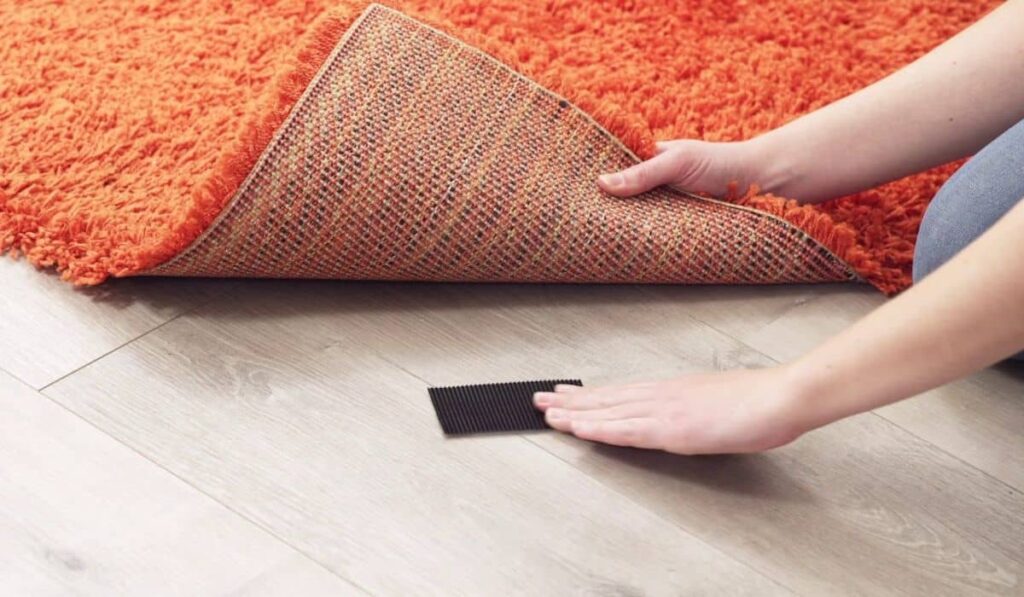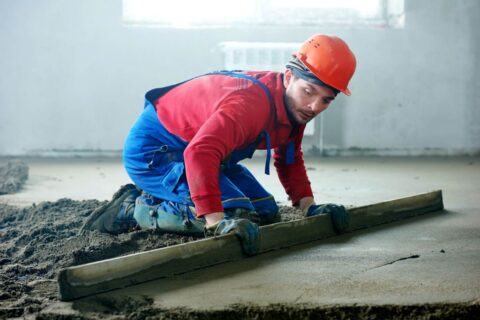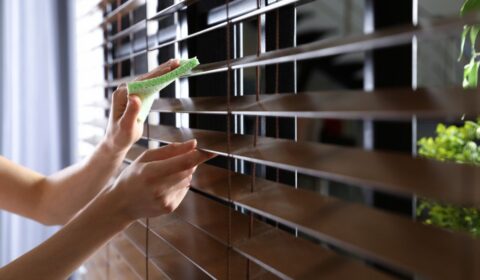Answer: To stop a rugs moving on carpet, use a rug-to-carpet grip pad, double-sided carpet tape, or rug grippers. You can also anchor the rug with furniture, apply Velcro strips, or try DIY methods like silicone caulk or shelf liners. Choose a method based on rug size, carpet type, and traffic level for best results.
Rugs on carpets can add warmth, style, and comfort to any space — but when they start shifting around, they can become a daily annoyance or even a safety hazard. Whether it’s a hallway runner that constantly creeps forward or a living room rug that crumples underfoot, finding ways to keep rugs in place on carpeted flooring is a common concern for homeowners and renters alike.
If you’re tired of readjusting your rug every time someone walks across the room, you’re in the right place. This comprehensive guide will show you how to stop rugs from moving on carpet using tried-and-tested solutions, from quick DIY fixes to premium anti-slip products.
Why Do Rugs Slip on Carpet?
Before tackling the solution, it helps to understand the problem. Rugs slip on carpets primarily due to a lack of friction between the rug backing and the soft carpet fibres. Unlike hard flooring, where a rubber-backed rug may stay put with ease, placing a rug on a carpet creates a soft-on-soft contact, offering little resistance to movement.
Here are some common causes:
- Lightweight rugs with little grip
- High foot traffic areas where rugs are regularly stepped on
- Plush or high-pile carpets that provide less grip
- Improper rug sizes relative to the carpet space
- Children or pets who run or play on the rug frequently
Luckily, no matter the reason, there are plenty of effective solutions available.
Must Read: Carpet and Rug Cleaning Hacks & Tricks You Want To Know
Best Methods to Stop Rugs Moving on Carpet
Let’s explore the most reliable ways to keep your rug securely in place.
Use a Rug-to-Carpet Grip Pad
One of the most effective and popular solutions is using a rug-to-carpet underlay or grip pad. These specially designed pads are placed between the rug and carpet to provide additional traction.
Benefits:
- Designed specifically for carpeted floors
- Non-adhesive and easy to reposition
- Prevents wrinkling and bunching
- Available in various sizes
Tip: Look for a high-quality rug pad made for carpet-on-carpet use, not one meant for hardwood or tile.
Apply Double-Sided Carpet Tape
Double-sided carpet tape is a straightforward and inexpensive method. Apply strips of the tape to the underside of the rug, then press it firmly onto the carpet.
Pros:
- Quick to apply
- Stronghold for lighter rugs
- Budget-friendly
Cons:
- Adhesive can leave residue over time
- May lose stickiness after repeated vacuuming
Best For: Temporary rug placement or small rugs that tend to move often.
Use Rug Anchors or Rug Grippers
Rug anchors and grippers are clever tools that secure rugs at the corners or along the edges. They usually feature hook-and-loop (Velcro) fasteners or non-slip silicone pads.
Advantages:
- Minimal damage to the carpet
- Easy to install and remove
- Effective for high-traffic areas
Pro Tip: For the best results, ensure the grippers are designed for use on carpet, not just hard flooring.
Try Non-Slip Rug Corners
Non-slip rug corners are triangular silicone or rubber pads that fit underneath each corner of your rug. They add weight and grip to the corners, preventing the carpet from curling or shifting.
Why They’re Great:
- Keep corners flat and neat
- Easy to apply without tools
- Useful for both carpet and hard floors
These are ideal if your rug tends to lift at the corners more than shift in its entirety.
Opt for Heavier Rugs or Layering
Sometimes, the simplest solution is choosing a rug that naturally stays in place. Heavier rugs with thick backings tend to grip better on carpeted surfaces. If you already have a lightweight rug, consider layering it over a larger, heavier base rug.
Benefits of Layering:
- Adds a stylish, textured look
- Increases overall weight and stability
- More grip area to reduce movement
Just make sure the bottom rug has a solid or grippy surface that doesn’t contribute to slipping.
Use Furniture as Natural Anchors
Anchoring rugs with furniture is a practical (and free) way to keep them in place. Place coffee tables, sofas, or side chairs on top of the rug to pin it down.
Benefits:
- No extra tools or purchases are needed
- Helps flatten rug edges and corners
- Creates a cohesive furniture layout
Just ensure that the furniture doesn’t create tension that causes the rug to buckle elsewhere.
Try Velcro Strips
For a more semi-permanent solution, you can apply Velcro strips to the rug and the carpet. Choose heavy-duty adhesive Velcro and place strips along the edges or corners.
What to Consider:
- Velcro is strong but may damage delicate carpet fibres
- Ideal for rugs in place for long periods
- Can be trimmed to size
Velcro works particularly well under rugs where movement is common, like playrooms or home offices.
DIY Home Hacks to Stop Rug Movement
If you don’t have access to anti-slip products or prefer a do-it-yourself approach, these home remedies may help:
Use Caulk Lines on the Back of the Rug
Apply silicone caulk in zigzag lines to the underside of your rug. Once dry, the hardened silicone will grip onto the carpet and prevent slipping.
Tip: Test on a small area first to ensure it doesn’t damage your rug’s fabric.
Try Shelf Liners or Rubber Matting
Non-slip shelf liners or rubber matting used in tool drawers can act as a makeshift rug pad. Cut them to size and place them underneath the rug for added friction.
Safety Pins at the Edges
Although not the most elegant solution, large safety pins can be used to fasten the rug to the carpet fibres. However, use them with caution, as they may cause carpet damage over time.
What to Avoid
Not all methods are safe or effective. Here’s what you should steer clear of:
- Standard rubber pads for hardwood floors – these often don’t work well on carpets.
- Glue or permanent adhesives – they may damage your rug or carpet.
- Low-quality rug tape – weak adhesive or poor materials won’t hold up to foot traffic.
Choosing the Right Method for Your Space
When deciding how to stop your rug from moving on carpet, consider the following:
- Room type: High-traffic areas like hallways and living rooms need stronger solutions.
- Rug material and weight: Heavier rugs tend to shift less, while lightweight rugs need more support.
- Carpet pile: Low-pile carpets may allow more grip than plush or shaggy ones.
- Temporary vs permanent: Decide whether you need a quick fix or a long-term solution.
Maintenance Tips to Keep Rugs in Place
Even after applying one of the above methods, regular maintenance helps your rug stay secure and look great:
- Vacuum both the rug and carpet regularly to prevent dust buildup that can reduce grip.
- Reposition furniture occasionally to check for wear or pressure marks.
- Inspect anti-slip pads or grippers every few months and replace them as needed.
- Rotate the rug every six months to prevent uneven wear.
Final Thoughts
Rugs moving on carpet may seem like a small issue, but if left unaddressed, it can become a daily nuisance and even a tripping hazard. Thankfully, with the right tools and methods, you can easily keep your rug in place and enjoy a safer, more stylish home.
From rug pads to clever DIY hacks, there’s a solution for every home, budget, and rug type. Test a few methods to find what works best for your space, and enjoy a slip-free rug experience once and for all.
If you found this guide helpful, feel free to share it with someone facing the same rug-related struggles. A stable rug not only improves your home’s safety but also keeps it looking sharp and well-kept.
Read More Blogs At: The Home Designer
Frequently Asked Questions
Will double-sided tape damage my carpet?
Some carpet tapes may leave residue or damage delicate carpet fibres over time. Always use tapes labelled safe for carpeted surfaces and test a small area first.
Can I use a rubber rug pad on the carpet?
Rubber pads designed for hard floors generally don't work well on carpet. They tend to bunch up or shift. Instead, opt for rug pads specifically made for carpeted flooring.
How do I stop a hallway runner from creeping forward?
Use rug grippers or an anti-slip underlay designed for long runners. If space allows, you can also secure the runner with furniture at either end.
Is there a natural way to stop rugs slipping without buying anything?
Yes. Placing furniture on the rug, using shelf liners, or applying silicone caulk lines to the underside can all provide a better grip without additional products.





